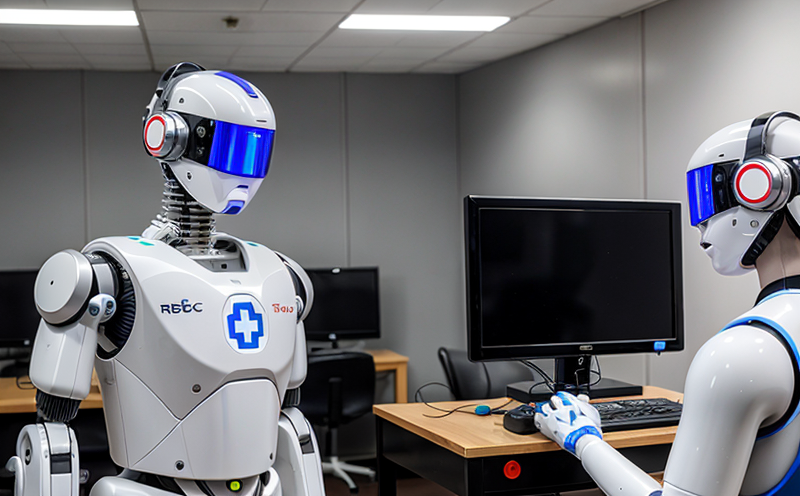ISO 80601-2-82 Patient Mobility Support Robot Testing
The ISO 80601-2-82 standard provides a comprehensive framework for the testing and evaluation of patient mobility support robots. This standard is crucial for ensuring that medical devices are safe, effective, and reliable in real-world conditions. The test protocols outlined in this standard address various aspects such as structural integrity, mechanical performance, electrical safety, and user interface.
The scope of ISO 80601-2-82 includes the design verification testing (DVT) and manufacturing quality control tests for patient mobility support robots. This ensures that these robotic systems meet stringent requirements before they are released to the market or used in healthcare settings. The standard applies not only to new products but also to modifications, updates, and repairs of existing devices.
The testing process involves a series of specific procedures aimed at evaluating different performance parameters. These tests are critical for identifying potential hazards and ensuring that the robot can perform its intended function without causing harm to patients or healthcare providers. Some key aspects tested under this standard include:
- Structural integrity checks
- Mechanical performance validation
- Electrical safety assessments
- User interface evaluations
- Interaction dynamics and stability testing
- Patient comfort and usability tests
The standard also emphasizes the importance of conducting these tests in a manner that simulates real-world use conditions. This ensures that any deficiencies or issues are identified early on, allowing manufacturers to make necessary adjustments before product release.
For quality managers and compliance officers, adhering to ISO 80601-2-82 is essential for maintaining regulatory compliance and ensuring the safety of medical devices in use. R&D engineers benefit from this standard by having a clear roadmap for testing new designs and modifications. Procurement teams can leverage these tests to verify that purchased equipment meets the required standards.
The rigorous nature of ISO 80601-2-82 ensures that patient mobility support robots are safe, reliable, and user-friendly. By following this standard, manufacturers can demonstrate their commitment to quality and safety, thereby gaining a competitive edge in the market.
Why Choose This Test
Selecting ISO 80601-2-82 for testing patient mobility support robots is essential for several reasons. Compliance with this standard ensures that your product meets the highest safety and quality standards, which is critical in the medical field where reliability cannot be compromised.
- Comprehensive Testing: The test covers multiple aspects including structural integrity, mechanical performance, electrical safety, and user interface.
- Regulatory Compliance: Adhering to this standard helps ensure that your product complies with international regulations and guidelines.
- Informed Decision-Making: The insights gained from thorough testing can inform product design decisions and improve overall quality.
- Competitive Advantage: Demonstrating compliance through certification enhances your brand’s reputation and market position.
By choosing to undergo ISO 80601-2-82 testing, you not only meet regulatory requirements but also set a benchmark for quality that can attract more customers and investors. This standard is recognized worldwide, providing an international perspective on medical device safety and effectiveness.
The comprehensive nature of the test ensures that any potential issues are identified early in the development or manufacturing process, allowing for timely corrections and improvements. This proactive approach can save significant time and resources by avoiding costly recalls or design modifications post-market release.
Environmental and Sustainability Contributions
The testing processes described in ISO 80601-2-82 play a crucial role not only in ensuring the safety of patient mobility support robots but also in promoting environmental sustainability. By adhering to these standards, manufacturers can design products that are not only safe for patients and users but also environmentally friendly.
The tests focus on minimizing energy consumption, reducing waste generation, and enhancing recyclability wherever possible. This contributes to a more sustainable healthcare industry by promoting the use of resources in an efficient manner while ensuring long-term availability of these resources.
Manufacturers who comply with ISO 80601-2-82 standards are encouraged to consider environmental factors throughout the product lifecycle, from design and manufacturing through distribution and end-of-life disposal. This holistic approach fosters innovation that integrates sustainability into core business strategies.
The rigorous testing protocols ensure that patient mobility support robots are designed with durability in mind, reducing the need for frequent replacements or repairs. Longer-lasting products contribute to reduced waste and lower environmental impact over time.
By choosing a laboratory that specializes in ISO 80601-2-82 testing, you not only enhance your product's safety and reliability but also demonstrate your commitment to sustainability practices. This aligns with global trends towards greener industries and supports the development of more eco-friendly technologies.
Competitive Advantage and Market Impact
The competitive landscape in medical robotics is increasingly stringent, with growing demands for safety, reliability, and innovation. ISO 80601-2-82 testing provides a clear advantage by ensuring that your product meets the highest international standards.
- Enhanced Safety: Compliance with this standard ensures that your product is free from hazards, enhancing user confidence and trust.
- Regulatory Approval: Meeting these stringent requirements can expedite regulatory approvals and market entry.
- Innovation Leadership: Demonstrating compliance through certification sets you apart as an industry leader in safety and innovation.
- Customer Satisfaction: Safe, reliable products lead to higher customer satisfaction and loyalty.
- Global Market Access: International standards like ISO ensure that your product is accepted globally, broadening market reach.
- Cost Efficiency: Early identification of issues through comprehensive testing can prevent costly rework or recalls later in the lifecycle.
The implementation of ISO 80601-2-82 also fosters innovation by encouraging continuous improvement and adaptation to new technologies. This adaptability is crucial as the medical robotics industry evolves rapidly, driven by advancements in AI and automation.
By investing in ISO 80601-2-82 testing, you not only comply with regulatory requirements but also gain a competitive edge that can significantly impact market performance. A well-tested product is more likely to attract investors, partners, and customers, contributing to long-term success in the industry.





